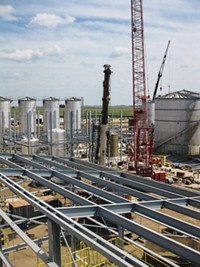Advertisement
Grab your lab coat. Let's get started
Welcome!
Welcome!
Create an account below to get 6 C&EN articles per month, receive newsletters and more - all free.
It seems this is your first time logging in online. Please enter the following information to continue.
As an ACS member you automatically get access to this site. All we need is few more details to create your reading experience.
Not you? Sign in with a different account.
Not you? Sign in with a different account.
ERROR 1
ERROR 1
ERROR 2
ERROR 2
ERROR 2
ERROR 2
ERROR 2
Password and Confirm password must match.
If you have an ACS member number, please enter it here so we can link this account to your membership. (optional)
ERROR 2
ACS values your privacy. By submitting your information, you are gaining access to C&EN and subscribing to our weekly newsletter. We use the information you provide to make your reading experience better, and we will never sell your data to third party members.
Environment
Cellulosic Ethanol Production Lags
Biofuels: National Research Council questions government’s output goals
by Jeff Johnson
October 10, 2011
| A version of this story appeared in
Volume 89, Issue 41

The U.S. is unlikely to reach cellulosic ethanol production mandates spelled out in the federal Renewable Fuel Standard (RFS), says a recent report by the National Research Council. The 423-page report also says a cloud of “uncertainty” surrounds environmental and economic benefits expected to spring from use of this biofuel.
“RFS may be an ineffective policy for reducing global greenhouse gas emissions,” says Ingrid C. Burke, cochair of the NRC panel that issued the report and a botany professor at the University of Wyoming.
The aim of RFS was to encourage development of biofuels, lower dependence on foreign oil, and reduce greenhouse gas emissions. It mandates that by 2022 the U.S. must produce 16 billion gal of cellulosic biofuels, along with 15 billion gal of conventional corn-based ethanol, 1 billion gal of biodiesel, and 4 billion gal of advanced biofuels. Whereas production of conventional ethanol and biodiesel already exceeds the mandate, no commercial cellulosic biofuels plants exist and technologies are only at demonstration scale.
This year, for instance, cellulosic biofuel output is likely to be 6.6 million gal, far below the RFS target for 2011 of 250 million gal, the report says.
The corn ethanol industry has been developing for 30 years, notes Wallace E. Tyner, panel cochair and Purdue University agricultural economics professor. “We have more than 200 corn ethanol plants producing more than 14 billion gal today,” he says. “We have only 11 years to reach even higher numbers for cellulosic biofuels. We would need a build rate three times that of corn ethanol.”
Only two commercial-scale cellulosic ethanol plants are currently in planning stages: an Abengoa Bioenergy Biomass plant in Kansas and an expansion of Poet’s conventional ethanol plant in Iowa, Tyner adds. Both are just breaking ground.
Additionally, greenhouse gas reductions and environmental benefits expected through cellulosic ethanol production are highly uncertain, Burke notes. For instance, if native plants on uncultivated land or commodity crops are ripped out to grow new energy crops, she says, the one-time release of greenhouse gases from disturbed biomass and soil may exceed future reductions of greenhouse gases expected as a result of the shift from gasoline to biofuels. In some cases, she says, intense biofuels production can even increase air emissions and reduce water availability, although the exact impact is highly site specific.
The report warns of increased competition for land among energy and food crops, raising the price of grain, livestock feed, and other farm commodities.
The report is “too narrow” and doesn’t reflect the evolving U.S. ethanol production, says Renewable Fuels Association Vice President Geoff Cooper. He adds that biofuels should be compared to what they will displace in the future, particularly “marginal sources of petroleum—shale oil and Canadian tar sands—that come with extreme environmental and economic costs.”
However, the report underscores the need to reform RFS, says the Environmental Working Group, with the addition of “strict and enforceable environmental safeguards.”




Join the conversation
Contact the reporter
Submit a Letter to the Editor for publication
Engage with us on Twitter